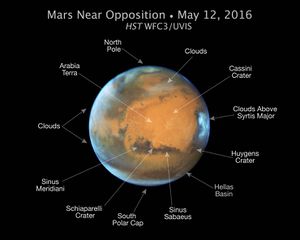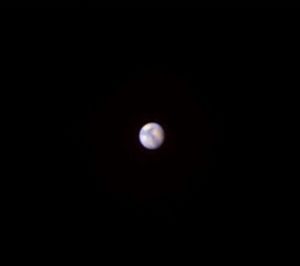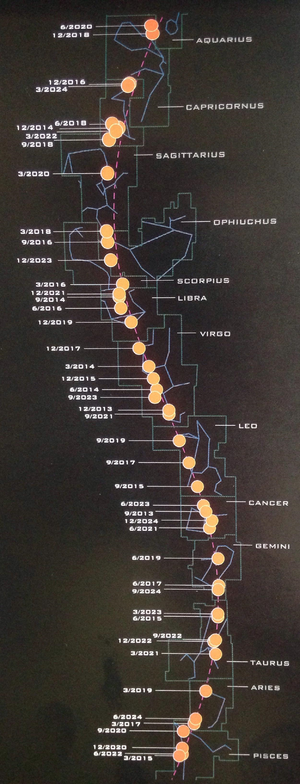Difference between revisions of "Observing Mars with a Telescope"
(Created page with "{{Stefan}} File:HubbleMars.jpg|thumb|right|Photograph of Mars taken by the Hubble Space Telescope in 2016. Click to enlarge and view the visible features which have been lab...") |
|||
| Line 1: | Line 1: | ||
{{Stefan}} | {{Stefan}} | ||
| − | [[File:HubbleMars.jpg|thumb| | + | [[File:HubbleMars.jpg|thumb|left|Photograph of Mars taken by the Hubble Space Telescope in 2016. Click to enlarge and view the visible features which have been labeled.]] |
| − | Mars constitutes the only planet in the solar system with surface features easily distinguishable from Earth—of the inner planets, Mercury’s small size and proximity to the sun make viewing exceptionally difficult, while Venus’ surface hides behind a thick layer of clouds. | + | [[File:Mars150x.jpg|thumb|right|Mars as it appears through a small telescope at 150x magnification.]] |
| + | Mars constitutes the only planet in the solar system with surface features easily distinguishable from Earth—of the inner planets, Mercury’s small size and proximity to the sun make viewing exceptionally difficult, while Venus’ surface hides behind a thick layer of clouds.<ref>Landers, Z. (2019, June 15). Viewing Mars With Your Telescope—Extensive Guide. Retrieved September 15, 2019, from Telescopic Watch website: <nowiki>https://telescopicwatch.com/viewing-mars-with-telescope/</nowiki></ref> As such, Martian surface features have long captured the imagination of astronomers, even helping lead to the longstanding popular belief of its inhabitation by extraterrestrial civilization. In 1877, Italian astronomer Giovanni Schiaparelli began mapping areas on Mars, including long, dark lines he named “channels”, or “canali."<ref>Canright, S. (2009, April 13). NASA - The “Canali” and the First Martians [Learning Materials]. Retrieved September 15, 2019, from NASA website: <nowiki>https://www.nasa.gov/audience/forstudents/postsecondary/features/F_Canali_and_First_Martians.html</nowiki></ref> Mistranslations of this word to English “canals” along with his own observations encouraged American Percival Lowell to theorize that these dark lines were the work of intelligent beings attempting to irrigate their dying planet.<ref>Milner, R. (2011, October 6). Tracing the Canals of Mars: An Astronomer’s Obsession. Retrieved September 15, 2019, from Space.com website: <nowiki>https://www.space.com/13197-mars-canals-water-history-lowell.html</nowiki></ref> Although these lines were soon after revealed to be an optical illusion resulting from the mind’s attempts to connect dark areas at the extent of its vision,<ref>Evans, J. E., & Maunder, E. W. (1903). Experiments as to the actuality of the" Canals" observed on Mars. ''Monthly Notices of the Royal Astronomical Society'', ''63'', 488-499.</ref> even amateur astronomers can make out a variety of other surface features with the aid of a telescope. | ||
| + | |||
| + | ==When can Mars be seen?== | ||
| + | [[File:MarsInZodiac.png|thumb|left|Chart depicting the progression of Mars through the zodiac constellations at three-month intervals. Gaps in the sequence indicate when Mars is too close to the Sun to be seen.]] | ||
Revision as of 10:26, 15 September 2019
volunteer for The Mars Society
It is licensed under Creative Commons BY-SA 3.0 and may be freely shared, but must include this attribution.
Mars constitutes the only planet in the solar system with surface features easily distinguishable from Earth—of the inner planets, Mercury’s small size and proximity to the sun make viewing exceptionally difficult, while Venus’ surface hides behind a thick layer of clouds.[1] As such, Martian surface features have long captured the imagination of astronomers, even helping lead to the longstanding popular belief of its inhabitation by extraterrestrial civilization. In 1877, Italian astronomer Giovanni Schiaparelli began mapping areas on Mars, including long, dark lines he named “channels”, or “canali."[2] Mistranslations of this word to English “canals” along with his own observations encouraged American Percival Lowell to theorize that these dark lines were the work of intelligent beings attempting to irrigate their dying planet.[3] Although these lines were soon after revealed to be an optical illusion resulting from the mind’s attempts to connect dark areas at the extent of its vision,[4] even amateur astronomers can make out a variety of other surface features with the aid of a telescope.
When can Mars be seen?
- ↑ Landers, Z. (2019, June 15). Viewing Mars With Your Telescope—Extensive Guide. Retrieved September 15, 2019, from Telescopic Watch website: https://telescopicwatch.com/viewing-mars-with-telescope/
- ↑ Canright, S. (2009, April 13). NASA - The “Canali” and the First Martians [Learning Materials]. Retrieved September 15, 2019, from NASA website: https://www.nasa.gov/audience/forstudents/postsecondary/features/F_Canali_and_First_Martians.html
- ↑ Milner, R. (2011, October 6). Tracing the Canals of Mars: An Astronomer’s Obsession. Retrieved September 15, 2019, from Space.com website: https://www.space.com/13197-mars-canals-water-history-lowell.html
- ↑ Evans, J. E., & Maunder, E. W. (1903). Experiments as to the actuality of the" Canals" observed on Mars. Monthly Notices of the Royal Astronomical Society, 63, 488-499.










